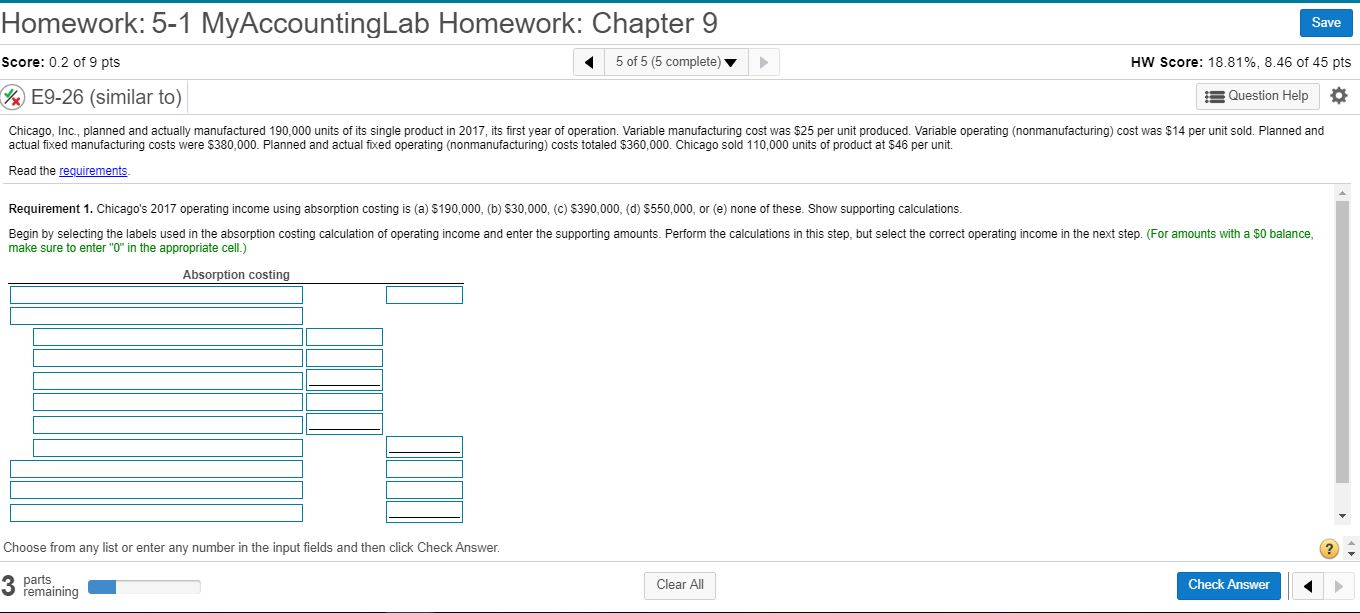Answered step by step
Verified Expert Solution
Question
1 Approved Answer
Revenues? Costs of goods sold? Beginning inventory? Variable manufacturing costs? Allocated Fixed manufacturing costs? Cost of goods available for sale? Deduct ending inventory? Cost of


Revenues?
Costs of goods sold?
Beginning inventory?
Variable manufacturing costs?
Allocated Fixed manufacturing costs?
Cost of goods available for sale?
Deduct ending inventory?
Cost of goods sold?
Gross margin?
Variable operating costs?
Fixed operating costs?
Requirement (2)
Revenues?
Variable cost of goods sold?
Beginning inventory?
Variable manufacturing costs?
Cost of goods available for sale?
Deduct ending inventory?
Variable cost of goods sold?
Variable operating costs?
Contribution margin?
Fixed manufacturing costs?
Fixed operating costs?
Homework: 5-1 MyAccountingLab Homework: Chapter 9 Save Score: 0.2 of 9 pts 5 of 5 (5 complete) HW Score: 18.81%, 8.46 of 45 pts %E9-26 (similar to) Question Help Chicago, Inc., planned and actually manufactured 190,000 units of its single product in 2017, its first year of operation. Variable manufacturing cost was $25 per unit produced. Variable operating (nonmanufacturing) cost was $14 per unit sold. Planned and actual fixed manufacturing costs were $380,000. Planned and actual fixed operating (nonmanufacturing) costs totaled $360,000. Chicago sold 110,000 units of product at $46 per unit. Read the requirements Requirement 1. Chicago's 2017 operating income using absorption costing is (a) $190,000, (b) $30,000. (C) $390,000, (d) $550,000, or (e) none of these. Show supporting calculations. Begin by selecting the labels used in the absorption costing calculation of operating income and enter the supporting amounts. Perform the calculations in this step, but select the correct operating income in the next step. (For amounts with a $0 balance, make sure to enter "0" in the appropriate cell.) Absorption costing Choose from any list or enter any number in the input fields and then click Check Answer. 3 parts Clear All Check Answer remaining Requirement 2. Osawa's 2017 operating income using variable costing is (a) $530,000, (b) 5310,000, (C) $50.000, (d) $400,000, or (e) none of these. Show supporting calculations. Begin by selecting the labels used in the variable costing calculation of operating income and enter the supporting amounts. Perform the calculations in this step, but select the correct operating income in the next step. (For amounts with a 50 balance, make sure to enter "0" in the appropriate cell.) Variable costing Choose from any list or enter any number in the input fields and then click Check Answer. part remaining Clear All CheckStep by Step Solution
There are 3 Steps involved in it
Step: 1

Get Instant Access to Expert-Tailored Solutions
See step-by-step solutions with expert insights and AI powered tools for academic success
Step: 2

Step: 3

Ace Your Homework with AI
Get the answers you need in no time with our AI-driven, step-by-step assistance
Get Started


